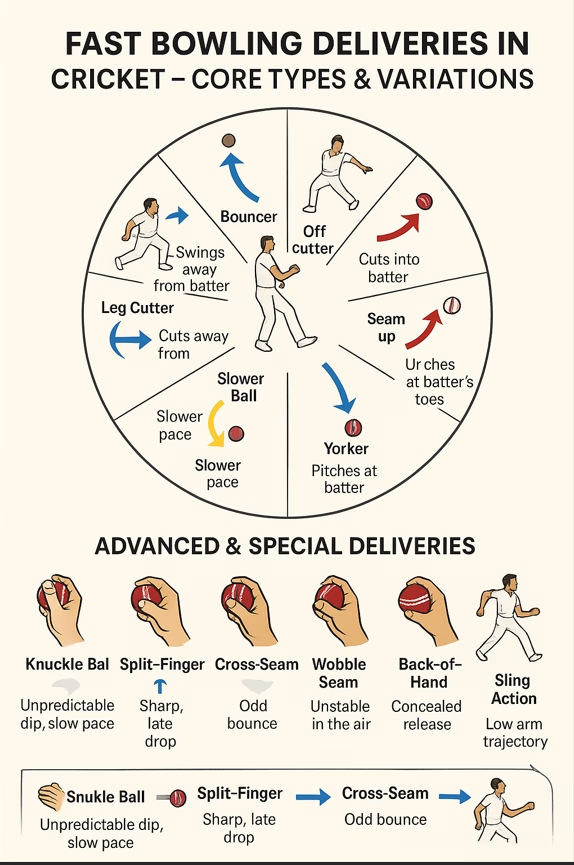Fast bowling isn’t just about raw speed—it’s a complex craft. Fast bowlers use skill, precision, and strategy to outsmart batters. Each delivery they bowl is a calculated move, designed to test the batter’s technique, timing, and decision-making.
From swinging the ball through the air to hitting the perfect length on the pitch, there’s a lot more going on than meets the eye. Let’s dive into the 12 core types of fast bowling deliveries, how batters typically respond, and what risks each one brings. We’ll then explore some advanced and hybrid variations used by elite bowlers on the world stage.
The 12 Core Fast Bowling Deliveries
1. Outswinger
- What it does: Moves away from a right-handed batter after release.
- Batting options: Leave, cover drive, square drive, backfoot punch, cut shot.
- Risk: Mistiming can result in edges to slips or the wicketkeeper.
2. Inswinger
- What it does: Swings into the batter from outside off stump.
- Batting options: Flick off the pads, straight drive, defensive shot.
- Risk: Missing the ball could lead to being bowled or trapped LBW.
3. Reverse Swing
- What it does: With an older ball, swings late and in the opposite direction to traditional swing.
- Batting options: Similar to inswing or outswing, but with extra caution.
- Risk: Unpredictable and often catches even experienced batters off guard.
4. Bouncer
- What it does: Rises sharply to chest or head height after pitching.
- Batting options: Duck, sway, hook shot, pull shot.
- Risk: Misjudging it can result in injury or a top-edge catch.
5. Yorker
- What it does: Lands at the batter’s feet or base of the stumps.
- Batting options: Dig it out, straight drive, flick.
- Risk: Hard to defend—miss it and you’re likely bowled or LBW.
6. Slower Ball
- What it does: Disguised as a fast delivery but arrives slower.
- Batting options: Wait and time the shot, lofted drive, soft push.
- Risk: Early shot = easy catch.
7. Off-Cutter
- What it does: Deviates inwards after pitching, like an off-spin.
- Batting options: Flick, mid-wicket drive, straight drive.
- Risk: Can result in an inside edge or complete miss.
8. Leg-Cutter
- What it does: Deviates away from a right-hander after pitching.
- Batting options: Cut shot, square drive.
- Risk: May catch the edge if it grips and moves late.
9. Seam-Up / Good Length
- What it does: Lands in a challenging area, allowing for seam movement.
- Batting options: Backfoot defense, punch, or leave.
- Risk: Tricky to read—may bounce, move, or stay low.
10. Short of a Length
- What it does: Sits awkwardly between a full ball and a bouncer.
- Batting options: Pull shot, backfoot punch, block.
- Risk: Can surprise batters—leading to edges or glove contact.
11. Beamer (Illegal)
- What it does: A full toss above waist height—dangerous and outlawed.
- Batting options: Duck, block, or instinctive pull.
- Risk: High chance of injury and difficult to react to.
12. Wide Yorker
- What it does: Full and wide outside off stump.
- Batting options: Square drive, reach-and-cut, or safe leave.
- Risk: Chasing it can result in an edge to slips or the keeper.
🧠 Beyond the Basics: Advanced & Hybrid Variations
Mastering the basics is just the beginning. Top-tier fast bowlers develop special deliveries—variations tailored to their style, conditions, and game format. These aren’t entirely new balls, but smart blends of speed, seam, swing, and deception.
13. Knuckle Ball
- What it does: Delivered with the knuckles, dropping pace drastically.
- Effect: Slower and hard to pick—great for T20s.
14. Split-Finger Delivery
- What it does: Held with fingers spread wide.
- Effect: Dips and floats, deceiving the batter’s timing.
15. Cross-Seam Ball
- What it does: Bowled with the seam across the pitch, not upright.
- Effect: Unpredictable bounce or skids off the surface.
16. Wobble Seam Delivery
- What it does: The seam wobbles in flight.
- Effect: Causes late movement—especially deadly on responsive pitches.
- Used by: Mohammed Shami, known for late seam deviation.
17. Back-of-the-Hand Slower Ball
- What it does: Released from behind the hand.
- Effect: Very slow, very deceptive—tricky to spot under lights.
18. Round-Arm or Sling Action
- What it does: Bowled with a low, slingy release.
- Used by: Lasith Malinga, ideal for deadly yorkers and angled slower balls.
Examples of Elite Variations
Top bowlers often combine standard deliveries into lethal variations:
- Jofra Archer’s “heavy ball” – Seems normal but kicks off the pitch quicker than expected.
- Shaheen Afridi’s swinging yorkers – Late swing at full pace, often unplayable in the powerplay or death overs.
- Mitchell Starc’s angle + reverse swing – Left-arm threat with sharp movement at speed.
